Cultivation of the Homeland(s): Latin American Transnational Foodways as the Preservation of Authenticity and Cultural Continuity
by Andrea R. Martinez M.
Compared to other ethnic immigrant groups in Vancouver, Latin American communities and their foodway’s settlement in the city have only begun developing in the last few decades due to sociopolitical instability that has resulted in different migratory waves since the 1970s and 1980s. If you google Latin American restaurants or stores near you, you will likely get limited results, with some of them not even being owned by Latin American people, but being what Elizabeth Zanoni refers to as Tipo-Italiano, or in this case, Tipo-Latino: more ‘digestible’ or manipulated Latin American foods for Vancouverites, which out of lack of exposure, might generalize Latino dishes through a handful of ingredients and cultural markers, leading to the branding of Tex-Mex or a Chipotle burrito as authentic ‘Latino’ food. Yet, as Latin American immigration to Canada increases, and with a significant amount of trade liberalization between Canada and countries like Mexico, Honduras, Chile, Peru, etc., knowledge of each Latino country’s authentic cuisine is propagated and celebrated. With the previous in mind, I seek to evaluate the importance of Latin American foodways and business settlements in Vancouver as growing transnational networks that promote authenticity and cultural continuity. This argument will be explored through the foodway history of Patricia, the owner’s daughter of Salvadoran, Honduran, and Mexican restaurant El Caracol Café, while considering Zanoni’s Migrant Marketplaces: Food and Italians in North and South America.
El Caracol Café is located in the Kensington neighbourhood in East Vancouver, historically a very ethnically diverse working-class area. Entering the restaurant, the first thing I was struck by was the colours after being surrounded by Vancouver’s gloomy weather all morning. The shades of yellow and orange, the tropical mural, and the plants I was surrounded by all transported me to eating in mercados back in Mexico with family and friends. Before even talking to Patricia, I found cultural markers and products that further reflected the restaurant’s history and transnational context. The first thing I noticed was a man coming in asking in Spanish for platanos maduros, the type of banana preferred to make fried plantains, a staple in Central American and Caribbean cuisine. After that, I saw sacks of Maseca, Mexican cornflour likely used for the restaurant’s home-cooked pupusas, tamales, and tortillas. And finally, by the tables, I found the newspaper Sin Fronteras, the only Latin American newspaper in British Columbia and Washington State, containing relevant news and opinion essays of Latino voices in Canada and the United States. It also had significant advertisements of immigration lawyers and other Latino-owned establishments, seeking to target the interests of Latinos in Canada as well as promote a collaborative space for community businesses to connect with Latino households. Thus, El Caracol Café’s authenticity and character showed itself through mere observation. Connections to El Salvador, Honduras, and Mexico, as well as a shared essence of Latin American diaspora culture in Canada, were visible and reflected political, economic, and cultural knowledge, the population it caters, and stories of settlement and cultural continuance cultivating far away from the homeland(s).
Once I finished the pupusas I ordered, I asked Patricia questions about El Caracol Café’s settlement, their place within the community, and its transformation across the 20 years it has been in existence in Vancouver. My first question was about the goals of the restaurant. Patricia told me it was important to “supply the demand of Central American home-cooked foods,” especially as she said when El Caracol opened its doors circa 2002, “there were not many Central American restaurants.” This is especially significant because Salvadoran, Honduran, and Mexican migrant settlements have increased throughout the years, with the Salvadoran community being initially the most prominent and with most antiquity in Canada due to the 1980s civil war. Zanoni mentions,
“food products, rituals, and traditions also served as symbols through which migrants formed and maintained collective but changing transnational identities.”
Hence, considering the political and economic contexts of the previously mentioned countries, the possible forced migration, and the alienation of leaving one’s homeland, through food, businesses like El Caracol Café offer these migrant communities a safe collective space for cultural continuity and connection to “rituals and traditions” despite geographical distance. An important example is tamales during the holiday season, a traditional dish in Mexican and Central American celebrations, which El Caracol Café supplies. For Latino households in Vancouver, the holidays are likely not the same experience as they are back home due to factors like the weather, receiving society’s religious differences, language, family units, etc. Yet, reliance on the authenticity of foods, in this case tamales, forges the continuity of traditions and can simulate the missing familiarity lost to distance.
I proceeded to ask Patricia about business growth and demographic changes since El Caracol Café opened. She told me that the clientele has grown more than 100%, all by “word of mouth.” Despite catering primarily to Latinos, she notes it is specifically pupusas that have become extremely popular, “with people from all of Vancouver and various ethnic groups seeking to try them.” After this, Patricia circled back to a point she repeated multiple times: the importance of authenticity. As I asked her why open a Salvadoran, Honduran, and Mexican restaurant, she said,
“we wanted to promote a variety of dishes from these countries because we have lived there. We only choose countries from where we know their foods because it is important to maintain the originality and authenticity of the food.”
And she has remained largely successful, as the only significant recipe adjustment she has made has been to the pupusas cheese, which is hard to import due to freshness. Ultimately, her answers depict a commitment to authenticity to bring comfort to Latino communities while also showcasing the true flavours of what Salvadoran/Honduran/Mexican dishes are like to Vancouverites. Patricia’s spread of culture is similar to Zanoni’s comparison with Italians being “free travelling salesmen” who share their foodways with whom they come in contact.
By the end, Patricia added her mother, the owner of the business, is a single mother of three who owned a restaurant in El Salvador. When they resettled in Canada, Patricia’s mother sold pupusas in beauty salons and fútbol games to afford to buy El Caracol Café. Thus, Patricia’s family settlement history and their promotion of food authenticity reflect growing Latin American foodways in Vancouver and cultural resilience and continuity, that despite contextual or geographical barriers, expand as more migrants arrive looking to connect with the roots they left behind. Simultaneously, through the embrace of authenticity, El Caracol Café challenges Tipo-Latino conceptions and exposes Vancouverites to a diverse multitude of authentic flavours that, before the settlements of restaurants like those of Patricia’s family, could only be found in the homeland(s).
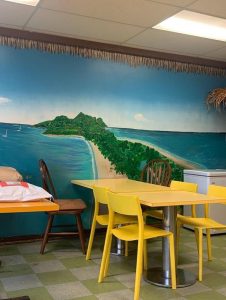
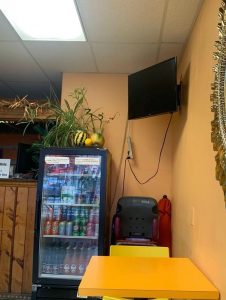
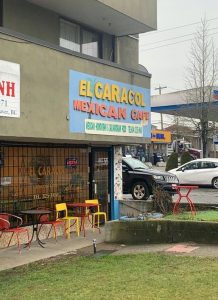
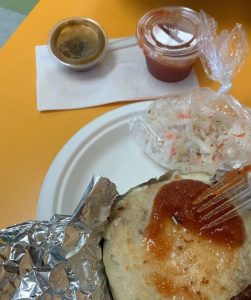
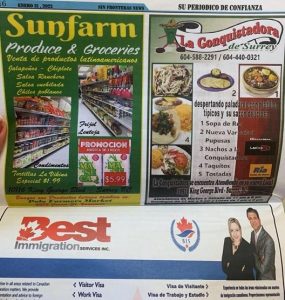
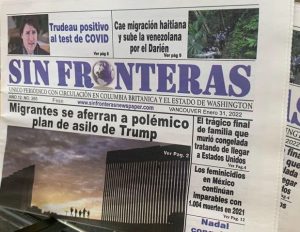
(All photos taken by the author)
Bibliography
City of Vancouver – Kensington-Cedar Cottage. “Kensington-Cedar Cottage Census Data.” (2016)
Government of Canada – Canada and The World. “Canada and Latin America and the Caribbean.” (2020)
Interview of Patricia by Andrea Martinez. El Caracol Café, Vancouver B.C. February 9th, 2022.
Mata, Fernando. “The Immigrant Waves from Latin American to Canada: A Look at Immigration and Census Statistics.” School of Sociological and Anthropological Studies (2021): 1-24.
Zanoni, Elizabeth. “Migrant Marketplaces: Globalizing Histories of Migrant Foodways.” Global Food History 4, no. 1 (2018): 3-21.
